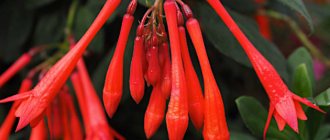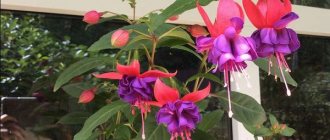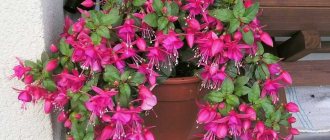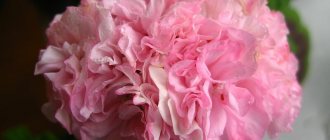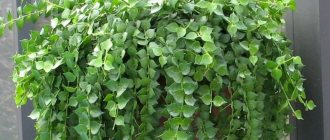Fuchsia is a plant from the genus Willowherb and is a perennial. The flower got its name from the name of Leonart Fuchs, a famous botanist. Widely distributed in Central and South America.
Indoor fuchsia has long been loved by residents almost all over the world. Fuchsia is a bright, very elegant interior decoration. The unusual shape of flowers and fantastic colors will create a harmonious accent in a room of any style. In honor of one of the most popular shades of fuchsia flowers, designers and artists even came up with the same name for the color - fuchsia.
Fuchsia is not only a beautiful decorative element, but also an easy-to-care plant. However, it is still necessary to get to know it better in order to avoid common mistakes and improve health and prolong the life of the flower.
Forms and varieties
There are about 100 types of fuchsia in total. For more than 200 years, fuchsia flowers have been grown in a variety of different hybrid varieties and forms. Unpretentious, persistent species of this plant bloom at different times of the year, so with proper selection, you can create an ever-blooming garden in your home.
Bush fuchsias upright
One of the most popular and widespread forms of fuchsias. Characterized by high, about 35-90 cm, frequently spaced branches. The cuttings are long, with oblong oval leaves with veins arranged in opposite order. The flowers resemble bright lanterns, arranged singly or collected in sparse racemes, which are located in the axils of the leaves.
Bush fuchsias are used to create trunks: the side shoots break off, so the flower grows only upward. The result is an expressive and spectacular floral column. If the plant is not trimmed on the sides, you will end up with a spherical bush with flowers all over the area - the natural appearance of this form.
The bush flower is suitable for growing both indoors and in gardens.
Ampelous fuchsias
Fuchsia ampelous has long, freely flowing, gracefully flexible stems. Thanks to this stem shape, the flower looks elegant in hanging pots that decorate verandas, gazebos, and loggias. The flowers of the plant are medium or very large in size. Their colors are very diverse: many shades from white and milky pink to deep purple. There are also two-color, terry and semi-double.
Often several cuttings are planted in one container - in this case the flowering becomes more voluminous and spreading.
Sometimes ampelous forms are grafted onto a standard tree, resulting in tall columnar trees with a weeping crown.
This form of fuchsia does not tolerate aggressive direct sunlight and does not tolerate drafts.
Semi-ampel fuchsias
Initially, semi-ampelic varieties are not much different from ordinary bush forms with erect shoots. The flowers of this fuchsia are large and voluminous; over time, they bend the stems towards the ground with their weight. As a result, during flowering the plant takes on a shape close to an ampelous one.
The flowers of semi-ampeled fuchsias are so heavy that they can break off shoots. To prevent this from happening, it is best to tie them to supports.
Forming and pruning shoots can significantly change the appearance of a flower, adjusting it to the desired shape that suits the overall style.
Description of fuchsia flower
Fuchsia is a perennial plant that belongs to the fireweed family, and in the wild includes more than a hundred species. The forms of fuchsia are very diverse. It can be in the form of a bush or a tree, but regardless of the type, it always pleases with beautiful, bright flowers in the shape of hanging tubes. It is for their flowers that fuchsia is valued and is nicknamed “gypsy earrings” in everyday life.
Its unpretentiousness and ability to survive in various conditions have made fuchsia an excellent pet. And botanists and breeders have developed many decorative varieties that have been decorating the interiors of European homes for several centuries.
Bush varieties
Avid flower lovers, despite their established favorites, are attracted to new varieties. Both beginners and experienced plant growers should study fuchsia varieties before planting: knowledge of their characteristics will allow them to grow a high-quality flowering, healthy plant.
Rohees New Millennium
One of the most fascinating fuchsia varieties. The bush is compact in size, its height is only about 40 cm. The shoots are strong, woody, making the flower suitable for forming into a tree. The leaves are elongated oval in shape, with a pointed tip. Rich light green color, smooth, with a pronounced skeleton. The flowers are medium and large, directed downwards. The variety is presented in one contrasting color combination: the sepals are light pink, the skirt is the color of overripe cherries. This color combination makes fuchsia look exotic.
Millennials complain about the problem of “reluctant” sluggish flowering out of season. In most cases, the problem can be resolved with timely feeding: the variety is sensitive to the lack of nutrients in the soil.
Andromeda
Fuchsia bush Andromeda is a tall plant, its height can reach up to 90 cm. The shoots quickly become woody, which makes it possible to grow the bush in the form of a trunk, but it is also incredibly beautiful growing in any order. Growth is fast.
How does fuchsia reproduce?
Exotic propagates well by seeds and cuttings. Despite the fact that you can collect fuchsia seeds yourself at the end of the season, we do not recommend the seed method. It is so complex and unpredictable that it is best left to specialists. In addition, propagation by seeds does not completely preserve the characteristics of the mother variety. But reproduction by cuttings is a simple and hassle-free task.
You can cut and root cuttings at any time of the year, except winter. If cuttings are carried out in the autumn months, take care to provide the seedlings with sufficient light for 12-14 hours. Another condition for obtaining a guaranteed result: cut not young shoots, but semi-lignified branches. You can root cuttings either in a container with water or in a closed mini-greenhouse.
If the second option is chosen, peat and sand mixed in equal parts are used as soil. Two weeks after the appearance of root shoots, the seedling is transplanted to a permanent place of residence. The main recommendation for caring for rooted seedlings is no fertilizing for the first three weeks!
Ampel varieties
The ampelous shape of fuchsia creates a festive mood. Varieties of these flowers take root well on terraces and balconies in hanging flowerpots. Plants in pots that decorate arches and bridges look very beautiful.
Golden Marinka
The flower has weak branches and blooms profusely and luxuriantly. Marinka's shoots are small, only up to 30 cm. Cuttings take a long time to take root. The shoots are strong and strong and do not break off, however, pinching the apical buds is necessary to preserve the aesthetic appearance.
The leaves are medium-sized, variegated, from light yellow-green to deep yellow. Oblong and smooth, the tip is pointed. The flowers are simple, semi-double are less common. The size is medium, the skirt and sepals are bright red.
It must be taken into account that the variety is susceptible to excess moisture.
Isisl (Icicle)
One of the most delicate fuchsia varieties. The bush is vigorous. The shoots are reddish in color and do not become very woody. Flowering is abundant and lush.
The leaves are rich green, the veins are red-brown. Medium size, smooth, oval in shape with a pointed tip. The flowers are very large, with long light milky sepals and a voluminous pale pink skirt.
The variety does not tolerate sunlight and gets burned quickly. Cuttings take root with difficulty, so it is quite rare to see such fuchsia.
First Love
Also a rare variety. Characteristic features: rapid growth and branching, graceful shoots, elongated buds.
The leaves are dense, elongated oval in shape, medium green in color. The sepals are snow-white, slightly powdered with a light pinkish haze. The skirt is fluffy, a delicate pink shade, with a pink blush at the base. The flowers are large.
Cuttings take root slowly and with difficulty. Like most fuchsias with light flowers, they quickly get burned.
Semi-ampel varieties
Fuchsias are interesting in shape and change their appearance. Experimenting with the formation of a bush will create a unique charm and zest in the room or on the site.
Fairy
A medium-sized bush with delicate lush flowers of incredible beauty. Shoots reach sizes up to 35 cm.
The leaves are quite large, rounded, moderately green in color. They have brown veins. The flowers are voluminous. The sepals are a cool milky pink hue, the petals are elongated, terry, raised and curled. The skirt is lilac-violet, with a blue tint, silky.
A relatively unpretentious variety to care for, it grows and develops quickly. The shoots become woody, which makes it possible to form a trunk.
Golden Monique
A weakly branching bush. Blooms abundantly, flowers are small. The shoots are woody and can be grown in the form of a small tree.
The leaves are decorative and look beautiful in the dormant phase. They have a golden-green hue, decorated with reddish veins. The flowers are double, the sepals are deep reddish-pink. The skirt is bright pink.
The unpretentious fuchsia of this variety winters well and loves good lighting. With a lack of sun, the leaves turn green and lose their yellow tint. Cuttings quickly and easily produce roots.
La Fiesta
Medium-sized variety, shoots reach a length of up to 40 cm. The shoots are strong, branching. The buds are elongated, flowering is abundant.
The leaves are light to medium green with purple veins. The flowers are large, the sepals are oblong, white with pale green tips. The skirt is bright red, with a raspberry tint, and decorated with pink strokes.
Cuttings root slowly.
Fuchsia growing and care at home
Fuchsia is not a very demanding plant; even a beginner can cope with its cultivation. However, it is worth immediately learning how to care for fuchsia correctly so that the flower does not die, and the flowering is lush and abundant and pleasing to the eye. Contemplating the results of your own labors is the best reward.
Selection of location and soil
The basis for the health of any plant is proper planting in suitable soil. It is optimal when the soil for fuchsia consists of a mixture of three parts leaf soil, two parts peat and one part sand. It is necessary to strictly observe the proportions, then the soil will be fertile and will help the flower gain strength before the upcoming flowering.
It should be taken into account that different varieties of fuchsia prefer different light levels and temperatures. It is best to choose a place without direct sun, strong drafts and hot air flows from heating radiators.
Landing
A young purchased or borrowed flower should be planted immediately in a new soil mixture in a pot of a suitable size. To do this, drainage and soil are poured into the container, the root is hidden in the recess and soil is filled in again. After transplantation, you do not need to feed the plant, but it needs abundant watering and spraying. It is necessary to make a drainage layer in the soil, because most fuchsias do not tolerate stagnant moisture. The pot is placed in a well-lit place without direct sunlight.
Methods for propagating fuchsia
Seeds
To obtain seeds from home fuchsia flowers, you will have to carry out the procedure of artificial pollination - using a brush to transfer pollen from one flower to another. If there are several types of fuchsia, you can try to breed a hybrid yourself by mixing pollen from different flowers. This will not affect the overall appearance of the bush, but will give the flowers a new color.
The seeds obtained after flowering are completed are planted in a container with soil identical to adult fuchsia, watered and covered with plastic film or glass. The container with seeds is kept at a temperature of 18-20 degrees. Within a month, the seeds should sprout, then each shoot can be transplanted into a separate container.
Cuttings
For those types of fuchsias that grow slowly, the best propagation method is cuttings.
Stems 5-7 cm long should be placed in damp sand or a glass of water. After 3-4 weeks of staying in such an environment, roots will appear on the cuttings. Cuttings with young roots are planted in pots. At the same time, you can plant several sprouts in one pot, in which case the bushes will grow more lush.
For planting cuttings, a pot with a diameter of up to 10 cm and a substrate of leaf soil, turf soil, sand and humus (proportion 1:1:1:1) are suitable.
Cuttings quickly take root and grow, so they can give flowers in the first year of life.
Pests and diseases
Fuchsia is rarely attacked by pests; most problems arise due to poor care. Fortunately, almost all unpleasant situations can be quickly corrected.
The most common plant pests:
- spider mite, when it appears, the flower often reacts by dropping leaves;
- whitefly, which can be detected in time by noticing red spots on the leaves.
The fight against insects is successfully completed with the use of insecticides.
Frequent problems:
- quickly ending flowering caused by insufficiently cool conditions during wintering, lack of lighting during the ripening period of buds or excess nitrogen;
- loss of leaves due to improper watering, low or excessive lighting, low air humidity, high temperature;
- changes and pallor of the leaves indicate poor soil or excessive watering in winter;
- buds usually fall off as a result of drafts or sudden changes in light during their growing season.
Analyze the conditions under which the flower is kept and, if possible, eliminate the cause.
Caring for fuchsia in autumn and winter
Caring for fuchsia at home during the dormant period is not difficult, the main thing is to correctly arrange the conditions of detention. If you follow the wintering rules, the plant will delight you with beautiful flowering and healthy growth.
In autumn, the flower begins to prepare for the resting phase; in winter, it regains its strength. If you don’t help it by creating favorable conditions, then you shouldn’t expect good flowering from it in the spring. Remember that from the beginning of autumn, fertilizing stops and the intervals between watering increase. Withered leaves are removed, overgrown shoots are pruned. If pests are noticed, treatment is required.
Wintering in an apartment
Fuchsia can winter in an apartment. The ideal place for hibernation is an insulated glazed loggia or balcony, where the temperature ranges from 10 to 15 degrees. The pot should be placed in a place with diffused light, without direct sunlight. The container itself can be insulated with polystyrene foam or foam rubber or padding polyethylene film. The top of the soil is sprinkled with sawdust. The lower the temperature, the less frequent the watering. Many varieties of this plant can withstand frosts down to -10 degrees, but still you should not allow the soil to freeze to such an extent.
A bush that has overwintered at a normal room temperature of 18-24 degrees may bloom poorly or not bloom at all. If there is no other maintenance option, the frequency of watering is not reduced. Additionally, you can set the micro-ventilation mode on the window; this will not create strong drafts, and the temperature will drop slightly.
Wintering in the basement
During wintering, you can keep fuchsia in the basement, cellar or even garage. In the resting phase, it does not need bright light; if possible, you can turn on the phytolamp indoors for a short time at a great distance. It is necessary to take into account that if the room freezes, then there is a high probability that the plant will also freeze. You shouldn't leave it in such a place. Just in case, you should take care of insulating the pot and soil.
When there are no suitable conditions for wintering fuchsia, delegate the care of it to the closest responsible relative.
How to replant fuchsia correctly?
- The best time to move is early spring. At the beginning of the growing season, the immune system is strong enough to cope with any stress. And the adaptation of a flower transplanted in early spring is much faster. In winter, it is better not to touch the flower: even a simple move to a new place can destroy it.
- For picking or replanting, it is recommended to use a clay or ceramic flower pot. Natural material will reliably protect delicate roots from overheating. It should be large enough so that you don't have to replant the bush every year.
- Drainage is important. A drainage layer thickness of less than 3 cm does not guarantee against waterlogging of the soil.
- The soil. Good development and flowering can only be achieved using a substrate with a high humus content, enriched with organic compost. However, it should be slightly acidic, with a pH below 6.
- Fertilizers. During the spring and summer, it is recommended to fertilize the plants every two weeks by adding fertilizer to the irrigation water. From November to February, fertilizing is applied no more than once a month. To accelerate the formation of green mass, products with a high nitrogen content are needed. Blooming fuchsia needs feeding more than usual. And in order to create and maintain abundant flowering, compounds with a predominance of potassium and phosphorus are needed.
